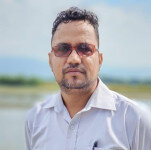Lumbini Province
Artificial ponds provide relief to wildlife in Bardiya National Park
Experts stress managing grasslands and water sources inside national parks to avoid human-animal conflict.
Dipendra Baduwal & Manoj Paudel
Bardiya National Park has been replenishing artificial ponds built inside the park for wild animals to ensure the animals have access to water amid drying up of natural water bodies due to the hot summer.
Bardiya National Park, one of the country’s major national parks in Tarai covering an area of 968 sq km, initiated the construction of artificial ponds some three decades ago to resolve the drinking water shortage for wildlife. Over the decades, the national park has constructed 180 artificial ponds, out of which 45 have water replenished throughout the year through solar-powered water pumps, according to Aashish Neupane, the information officer at the national park. The rest of the ponds rely on rainwater for replenishment.
According to Ashok Bhandari, chief conservation officer at the Bardiya National Park, the park constructs five to six such ponds every year. “The construction of ponds and availability of water throughout the year have boosted the tiger population, their prey animals and other wildlife,” said Bhandari. “The availability of water ensures the wildlife don’t venture out of the forest areas in search of water and reduces human-animal conflict.”
The artificial ponds are mainly constructed in grassland areas—Baghaura, Lamital and Lamkoili—far from the natural water sources. “We built artificial ponds this year as well. Most of the ponds were built in the Karnali floodplains and the Babai Valley this year. The national park has plans to build such ponds in Lami Damar, Guthi and Rambahara areas as well,” said Neupane.
“Two major rivers—Karnali and Babai—pass through the national park, but they are far from the major habitats of wildlife so the ponds are concentrated in areas where the animals congregate.”
Machans (platforms built on trees to observe animals), have also been constructed near the artificial ponds to promote wildlife tourism. “The animals come to the ponds to drink water providing some amazing opportunities for the tourists to watch and photograph them,” said Bhim Chaudhary, a nature guide from Thakurdwara area.
The national park in April conducted a study to gauge the effectiveness of the artificial ponds in conservation efforts. Park employees and conservationists closely monitored the movement of wild animals that visited 20 artificial ponds. “They found many species of wildlife visiting the ponds for water. Tigers, spotted deer and elephants were regular visitors,” said Neupane. “Their frequent visits to the ponds indicate that the construction of artificial ponds inside the national park was and is a good call.”
The artificial ponds are 50 metres to 100 metres long and about two metres deep. According to the park administration, it costs between Rs1.5 million and Rs1.7 million to build a pond depending on the geography. A pipe is bored around 100 metres underground to lift water. Various organisations working in the conservation sector including the Tarai Arc Landscape Project and National Trust for Nature Conservation provide financial and technical support to build these ponds.
Tigers, elephants and rhinos leave the forests when water and prey are scarce, therefore it is imperative to prioritise the management of grasslands and water sources inside the national parks to avoid human-animal conflict, say conservationists.
Bardiya is the largest national park in the Tarai and the second major habitat of tigers after the Chitwan National Park. Commending Bardiya National Park’s efforts towards ensuring the abundance of prey and water to the animals, Maheshwar Dhakal, director general of the Department of National Parks and Wildlife Conservation, said, “The population of tigers has increased in Bardiya lately due to the management of grassland and water sources.”
As per the latest tiger census, Nepal has a total of 355 tigers and 125 of them are in the Bardiya National Park.



 12.12°C Kathmandu
12.12°C Kathmandu












